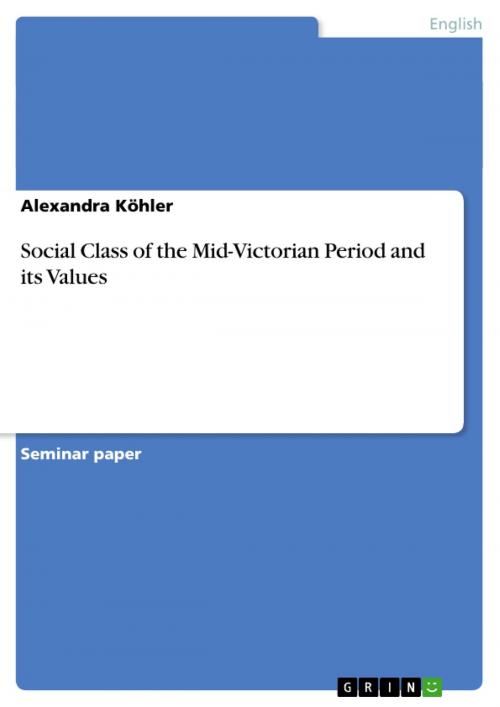Social Class of the Mid-Victorian Period and its Values
Nonfiction, Reference & Language, Study Aids, ESL, Foreign Languages| Author: | Alexandra Köhler | ISBN: | 9783640185535 |
| Publisher: | GRIN Verlag | Publication: | October 10, 2008 |
| Imprint: | GRIN Verlag | Language: | English |
| Author: | Alexandra Köhler |
| ISBN: | 9783640185535 |
| Publisher: | GRIN Verlag |
| Publication: | October 10, 2008 |
| Imprint: | GRIN Verlag |
| Language: | English |
Seminar paper from the year 2007 in the subject English Language and Literature Studies - Culture and Applied Geography, grade: Sehr gut, University of Osnabrück, course: Seminar, 9 entries in the bibliography, language: English, abstract: The term 'Victorian' remains a living concept in our daily society. The term is related to the reign of Queen Victoria of England from 1837 to 1901. Since it covers a wide time span, the era has been divided into the early-Victorian period (1837-1851), the mid-Victorian period (1851-1875) and the late-Victorian period (1875-1901). 'Victorian' is also used today to describe British furniture and architecture made during the greater part of the 19th century. Additionally it refers to British literary works which were written, for instance by Wilkie Collins or Charles Dickens. Furthermore specific social and moral attitudes are associated with the word 'Victorian.' The Victorian age was an age of transition. England was transformed from a feudal and agricultural society into an industrial democracy. Nevertheless the process of the industrial revolution did not only create progress but also problems. One drawback was the hierarchy which was created in the British society leading to a division of people into distinctive social classes. In order to analyze the class distinctions more precisely this term paper concentrates on the specific class divisions that arose especially between the middle class and the working class and on how these differences were characterized. In addition, the three well known Victorian values of the middle and working class, family life, respectability and self-help, are defined and discussed. Due to the fact that it is not possible to discuss the whole Victorian period as one homogenous era, the discussion of the social classes and their values is restricted to the mid-Victorian period. In order to understand the society in the Victorian era it is necessary to depict a brief overview of the historical circumstances concerning the Victorian society.
Alexandra Köhler ist Lehrerin, Fachseminarleiterin im Studienseminar und Lehrbeauftragte der Universität Oldenburg für die Praxisphase in den Masterstudiengängen im Fachbereich Anglistik/Amerikanistik.
Seminar paper from the year 2007 in the subject English Language and Literature Studies - Culture and Applied Geography, grade: Sehr gut, University of Osnabrück, course: Seminar, 9 entries in the bibliography, language: English, abstract: The term 'Victorian' remains a living concept in our daily society. The term is related to the reign of Queen Victoria of England from 1837 to 1901. Since it covers a wide time span, the era has been divided into the early-Victorian period (1837-1851), the mid-Victorian period (1851-1875) and the late-Victorian period (1875-1901). 'Victorian' is also used today to describe British furniture and architecture made during the greater part of the 19th century. Additionally it refers to British literary works which were written, for instance by Wilkie Collins or Charles Dickens. Furthermore specific social and moral attitudes are associated with the word 'Victorian.' The Victorian age was an age of transition. England was transformed from a feudal and agricultural society into an industrial democracy. Nevertheless the process of the industrial revolution did not only create progress but also problems. One drawback was the hierarchy which was created in the British society leading to a division of people into distinctive social classes. In order to analyze the class distinctions more precisely this term paper concentrates on the specific class divisions that arose especially between the middle class and the working class and on how these differences were characterized. In addition, the three well known Victorian values of the middle and working class, family life, respectability and self-help, are defined and discussed. Due to the fact that it is not possible to discuss the whole Victorian period as one homogenous era, the discussion of the social classes and their values is restricted to the mid-Victorian period. In order to understand the society in the Victorian era it is necessary to depict a brief overview of the historical circumstances concerning the Victorian society.
Alexandra Köhler ist Lehrerin, Fachseminarleiterin im Studienseminar und Lehrbeauftragte der Universität Oldenburg für die Praxisphase in den Masterstudiengängen im Fachbereich Anglistik/Amerikanistik.















